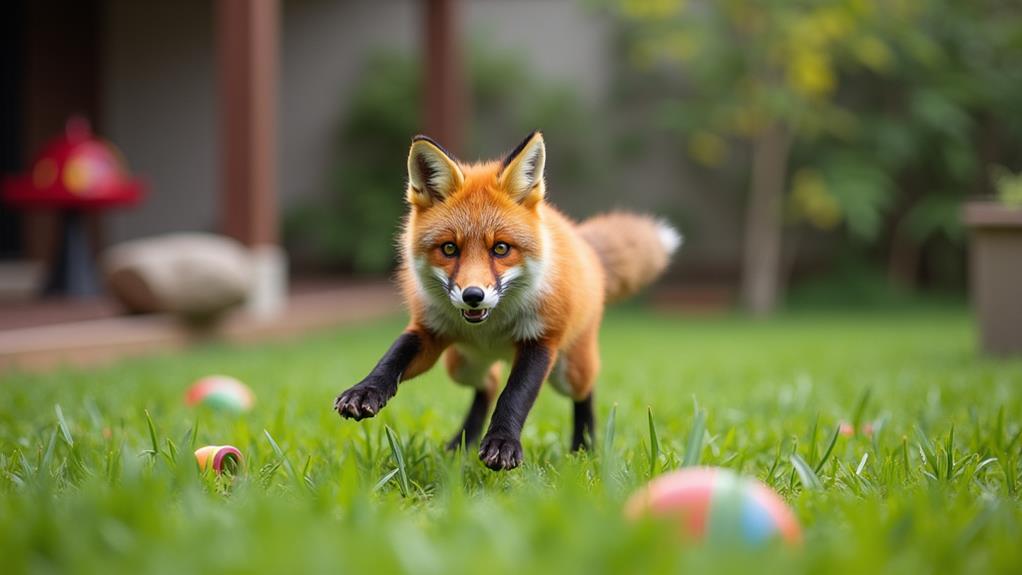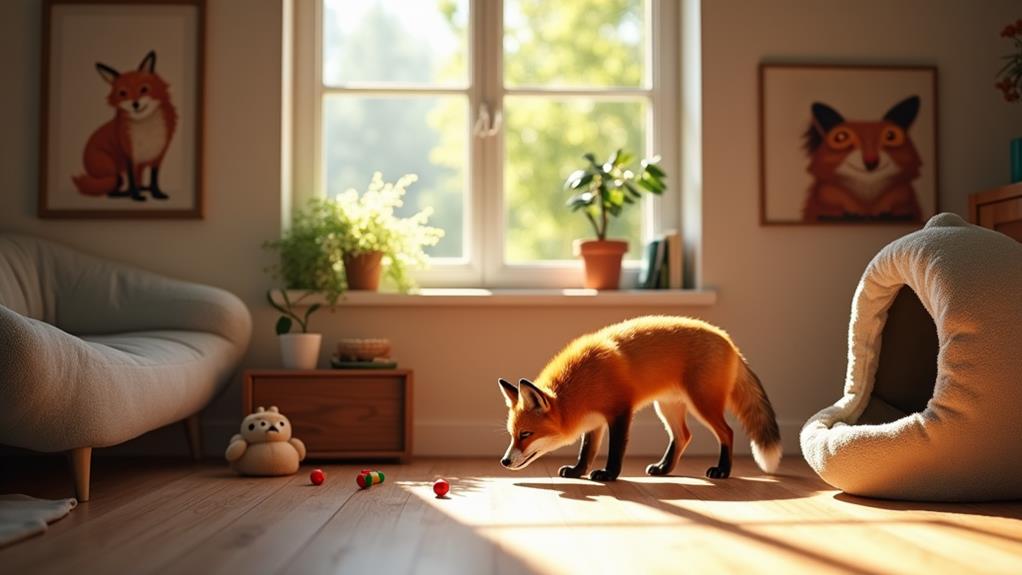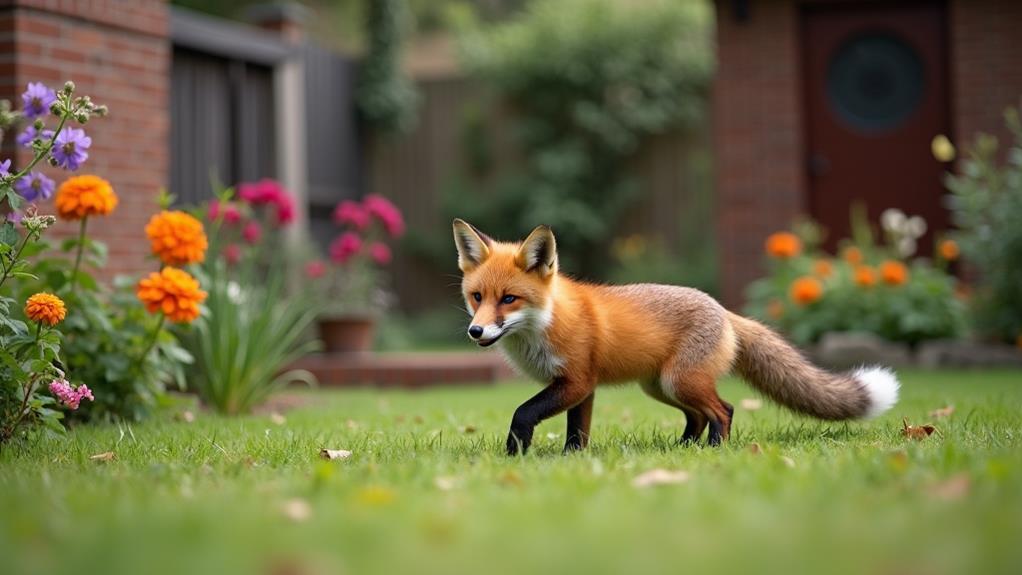Deciding if a red fox is a good pet for you involves more than just the adorable looks. First, check your local laws; many areas restrict fox ownership. Keep in mind that they have wild instincts, so they require tons of space, mental stimulation, and a specific diet. Housebreaking isn't easy either; let's just say marking territory is in their nature! Plus, you'll need to weigh safety for both your new furry friend and your family. If you're curious about the ins and outs of fox ownership and want to make an informed choice, keep exploring!
Contents
Legal Considerations for Fox Ownership

When considering a red fox as a pet, it's important to understand the legal landscape surrounding their ownership. The truth is, owning a fox isn't a walk in the park. Most states don't allow you to have foxes as pets, with only about 15 states giving the green light.
Even then, you'll often need specific permits—and guess what? Local laws might throw a curveball with additional restrictions.
It's vital to research the regulations in your area before getting too excited. Remember, you should only consider captive-bred red foxes, as bringing a wild one into your home is both illegal and unethical. Keeping wild animals as pets raises numerous wildlife concerns and ethical dilemmas.
To navigate this complicated terrain, reach out to your local fish and wildlife agencies. They provide the most accurate information on the regulations and permits that apply to you.
Just imagine trying to explain to your neighbors why you decided to adopt a fox instead of a dog! Make sure you're ready for the responsibility and committed to following the laws to guarantee a happy and legal relationship with your potential new furry friend.
Understanding Fox Behavior
Understanding a red fox's behavior is vital for potential owners who want to create a harmonious home environment. Unlike dogs, foxes retain wild instincts, which means your furry friend might exhibit behaviors you wouldn't expect.
They're high-energy animals, enthusiastic to explore and play, but if you don't engage them, they could release some serious destructive tendencies on your couch! Red foxes are adaptable creatures, capable of thriving in both urban and rural settings, which means they may exhibit behaviors influenced by their environment their adaptability to various settings.
Territorial marking is also a common issue with red foxes, leading to strong odors that can make house training more complicated than you'd like. Regular socialization and mental enrichment are important. Without enough stimulation, they might feel anxious or stressed, and trust me, a stressed fox isn't a happy fox!
If you're looking to live with these clever critters, be prepared for some loud vocalizations, especially during mating season—these little guys sure know how to make themselves heard!
Creating a loving environment for a red fox means understanding their unique instincts and providing the right activities to keep them happy. With some effort and dedication, you can enjoy a delightful, if slightly mischievous, companion.
Energy and Space Requirements

When you think about bringing a red fox into your home, remember they're not your average couch potato!
These lively critters need plenty of space to run, dig, and explore, which means a simple backyard won't cut it.
They're incredibly adaptable animals, thriving in diverse environments such as mixed landscapes and urban settings, but they require more than just physical space; they also need mental stimulation.
If you want a happy and healthy fox, you'll need to make room for an energetic companion who loves to move and play.
Space Needs Overview
Red foxes need ample space to flourish, ideally requiring several acres where they can run, play, and explore freely.
These intelligent and playful creatures thrive in environments that cater to their natural instincts and display remarkable versatility in various ecosystems worldwide. A large enclosure, around 25 square yards at the very least, is essential to provide adequate living conditions. Secure fencing is a must to keep them safe and prevent any escape artist tendencies!
When you think about space needs, consider how red foxes require room for daily physical stimulation and enrichment activities. Without sufficient space, they can become unhappy and may exhibit destructive behavior, like digging up your garden.
Imagine your fox, bored and restless, turning your flowerbeds into a construction site!
Keep in mind, red foxes can't live the indoor life; their high energy levels need outlets that only outdoor spaces can provide. By ensuring they've plenty of room to roam, you'll create a happy home for your unique friend.
Energy Levels Explained
With boundless energy and a curious nature, red foxes demand significant physical activity and mental stimulation to thrive. These lively animals aren't couch potatoes; they need ample space to roam and play.
Ideally, you should consider several acres of land to keep your red fox happy. Limited space can lead to unhappiness and destructive behaviors like digging up your garden or shredding your favorite shoes!
To keep up with their energy levels, regular physical stimulation is a must. Engaging activities can include chasing toys, foraging for treats, or creating fun obstacle courses.
It's essential to recognize that a minimum enclosure size of 25 square yards is recommended, but more room is always better for allowing them to express their natural behaviors.
Without enough exercise and stimulation, not only will your furry friend be bored, but they might also develop behavioral issues.
Nutritional Needs of Foxes
A well-balanced diet is essential for your pet fox to thrive, as these animals are omnivores that require specific nutritional components.
Red foxes are omnivores, which means their diet should consist of about 65-70% muscle meat, 10% raw bone, and a healthy mix of fruits and vegetables. Think about offering high-quality dog food as a base, but don't forget to include fresh raw meat like rabbit, poultry, and even seafood.
To spice things up, supplement their meals with fruits like apples and blueberries. These tasty treats provide essential nutrients.
Don't overlook organ meats, such as chicken hearts and livers; taurine is super important for preventing health issues like blindness or seizures. Eggs can be a fun addition too—just remember, it's best to offer boiled eggs to avoid biotin concerns with raw ones.
Lastly, keep your pet fox engaged by hiding their food or using foraging toys. This clever trick encourages natural foraging behaviors and helps combat boredom.
Housebreaking and Litter Training

When it comes to housebreaking a pet fox, you'll quickly discover it can be quite the challenge. Unlike dogs, most foxes aren't great at using a litter box. Their instinctive marking behaviors can lead to some indoor accidents, and trust me, you won't want to clean up fox urine. It has a strong scent that lingers, making thorough odor management essential.
You'll probably find some limited success with indoor litter boxes, but consistency is key. Expect frequent cleaning and be ready for the potential destruction of household items. Foxes, being curious critters, might turn something innocent into a chew toy.
One effective solution? Outdoor enclosures. They not only help accommodate your fox's natural behaviors but also reduce the chances of indoor messes. By having a safe outdoor space, you're giving your fox the freedom and environment it craves, making life a bit easier for you.
Safety and Health Concerns
Owning a red fox brings unique safety and health concerns that can't be overlooked. While they can be charming companions, their predatory nature and potential health risks require careful consideration.
Since red foxes are common carriers of rabies in North America and rabies vaccines haven't been tested on them, both you and your other pets could be at risk. You'll also face possible legal issues; local authorities might confiscate and euthanize foxes if they show aggressive behavior.
To keep everyone safe, here are some key points to keep in mind:
- Guarantee consistent monitoring and safety protocols to prevent bites and disease.
- Regular vet care from professionals experienced with exotic animals is essential.
- Be prepared to manage their interaction with smaller pets to reduce risks.
- Know that aggressive behavior can pose a threat, so training and socialization are important.
If you're willing to meet these challenges, a red fox might just steal your heart.
But remember, it takes more than just love to care for these unique creatures. Consider whether you can provide the specialized attention they truly need!
Community Insights on Fox Ownership

Many potential fox owners plunge into the discussion about keeping a red fox as a pet, revealing a blend of enthusiasm and caution. Community insights on fox ownership show that not everyone thinks it's a walk in the park. While some folks share stories of affectionate and quirky foxes, many stress the importance of thorough research.
You've got to be aware of legal regulations in your state, as they vary and can catch you off guard. It's also important to know that foxes as pets need a ton of daily socialization and enrichment. Without proper attention, they can show destructive behavior, which isn't fun for anyone—or your furniture!
Plus, remember that red fox behavior often includes wild instincts that might lead to a few pet fox bites if you're not careful. Perceptions of fox ownership can be skewed, thanks to some negative media portrayals, so it's key to educate yourself and others on responsible care practices.
Make sure you're fully committed before diving into fox ownership, as it's a rewarding adventure filled with its unique twists and turns. After all, every furry friend deserves a little love and understanding!
Final Thoughts
So, is a red fox the right pet for you? Think of it as adopting a spirited dancer—you'll need to match its moves! Weigh the legal bits, understand their quirky ways, and make sure you've got the energy and space to keep up. Providing the right food and health care is a must. If you're ready for a wild adventure, a fox might just be the delightful companion you never knew you needed!














